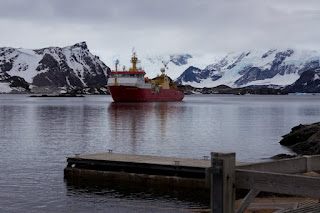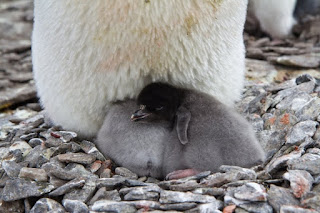Merry Christmas to everyone back home, from all of us (and the elephant seals!) at Signy.
Friday, 23 December 2016
Sunday, 18 December 2016
Visitors
There are only five of us at Signy this year. This is a bit unusual as we have eight beds available on station and often all of them are full. The number of people here depends on a couple of things- firstly, how many scientists have projects planned for the season, and then whether the ships travel itinery matches up with the scientists work plan and therefore whether the project is feasible. We do have two more scientists joining us in January bringing us up to seven on station.
Given the low numbers, a visit from a ship can suddenly seem a bit of a shock as the base transforms into a bustling hive of activity and people. The feelings are rather mixed. Part of you feels like your home is being invaded by tourists who wander through your living space, upsetting the fine balance of life that you have established with your fellow station members. The other part of you is quite excited, for they bring great enthusiasm and excitement, and sometimes new people or supplies.
Last week two ships visited. The first visit was from the Bark Europa.
The Bark Europa is a cruise ship with a difference. Unlike modern cruise ships, with all their luxuries, the Europa is a tall ship, over 100 years old, that had sailed all the way from Ushuaia, Argentina, using only the power of the wind. Originally a light ship, protecting a hazardous stretch of river in Germany, she was re-rigged as a Barque in the 1980's as a sail training ship. The tourists onboard all muck in together, working alongside the crew and trainee sailers on their exciting voyage.
After a tour of our station, they kindly repaid the favour, allowing us onboard for a tour of their ship and a cup of tea. There seemed to be an awful lot of ropes! Here is me, Doug and Iain onboard.
Both inside and out the Europa is beautiful. I suspect in a sea of icebergs, with all sails up, it must be quite a sight! Later they set sail, heading south towards the Antarctic Peninsula.
A couple of days later, one of our own ships, the Ernest Shackleton, came to visit. We awoke to find her parked almost on the doorstep!
The bay is too shallow for the Shackleton to reach the jetty, so they launched their small boats. The Shackleton was dropping of our new Scientist Jes and taking away our generator mechanic Doug, who has been here since the start of the season. It also brought us a new batch of fresh fruit and veg, and various bits of cargo. Onboard this time were a group of people bound for Halley research station, and they came ashore to help with cargo and have a look around. Again, we went onboard, this time for lunch and a chat with the captain and his crew.
Once the ships had gone, normality resumed and we settled back into work. The next ship we will see is the James Clark Ross (which we arrived on in November), around the end of January.
Sunday, 11 December 2016
Chicks
Time at Signy seems to pass very rapidly. Already we have been here a month, and in that time things have changed enormously. The photo's on my previous blog, show the state of things shortly after we first arrived. Now three weeks later, everything has moved on. The Adelies complete their entire breeding cycle in only 4 months, arriving mid October, and leaving Signy around Mid February. It is a race against time for them to rear their young and get them to sea early enough in the year so they have a chance of surviving the winter.
When hatching time approaches, the second parent returns to the nest. The colonies suddenly start to look much more busy.
The adelie chicks started hatching about a week ago, and on my visit to Gourlay yesterday, approximately one third of the eggs have now hatched. You can see this one is just starting to hatch. It will probably be a couple of days yet before the chick fully emerges from the egg.
Once hatched, they continue to be guarded by one parent or the other. Without this protection they are very vulnerable and perfect snack size for a hungry skua. The other parent will spend the day at sea catching krill or fish, and return in the evening to swap shifts with the guarding parent.
This Adelie has two chicks. In a good season, where food is plentiful, both chicks are likely to survive, but if food supplies are scarce, only the biggest will successfully fledge.
In other news, on Tuesday one of the BAS ships, the RRS Ernest Shackleton is coming to visit. They will take away our generator mechanic Doug, and bring in a new scientist. The weather is forecast to be kind to us, so we may be able to get on board to see a change of faces, and some fresh salad! The Shackleton then continues southwards, down to Halley.
Sunday, 4 December 2016
Bricks
Anyone who has followed my blog in previous seasons will be familiar with my numbered nest marker bricks.
My first job of the season is to lay these out through my penguin colonies to individually indentify 100 nests of each species. I will then visit each nest every few days throughout the entire breeding season to get laying, hatching and fledging dates. These nests are important as they act as a representation of the island as a whole, so I know when to do the large scale counts. For example, when the birds in my study nests have finished laying it is time to do the island wide egg count. Because the arrival dates for the birds can vary quite considerably, the date varies from year to year and the results would not be comparable if the egg count was always done on a set date in the calendar year. The whole point of me being here is that it is a long term monitoring site, and my role is to collect this years data for the longterm dataset, which for Signy now spans 40 years.
When i arrive at Signy, the breeding season is already in full swing. The Adelie penguins have been back at Signy since early October, and by the time I arrive they are busy incubating eggs.
Their neat little nests are built from pebbles. Although both parents incubate the eggs, only one bird is needed at a time. Their behaviour gives you a clue as to what they are doing- the birds in the picture below that are standing up will be failed breeders- either ones who somehow didn't quite get something right, or ones where the predatory skuas have pinched their eggs. They will not breed again this year. The laying down birds will be incubating eggs.
This one has two eggs and is standing up briefly to adjust them and check they are still there.
The chinstrap penguins always breed about a month later than the Adelies. When we arrived the male birds had already arrived and were fiercely defending their chosen nest sites from fellow penguins.
Nest building requires dedication. Leaving the nest site for too long leaves the risk of someone else coming along and taking it over, resulting in some fairly vicious fighting. Alternatively they may return to find a neighbour has pinched all of the carefully chosen stones for their own nest. It is not uncommon to watch one bird wandering backwards and forwards stealing a neighbours stones, while someone else is doing the same with their own nest.
Now, a couple of weeks later, the females have also arrived and the chinstraps are in the middle of the egg laying period. The Adelie chicks should start hatching any day now, but I haven't seen any chicks yet.
















